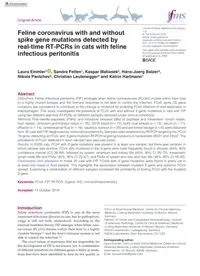
2019 Feline coronavirus with and without spike gene mutations detected by real-time RT-PCRs in cats with feline infectio PDF
Preview 2019 Feline coronavirus with and without spike gene mutations detected by real-time RT-PCRs in cats with feline infectio
https://doi.org/10.1177/1098612X19886671 Journal of Feline Medicine and Surgery 1 –9 © The Author(s) 2019 Article reuse guidelines: sagepub.com/journals-permissions DOI: 10.1177/1098612X19886671 journals.sagepub.com/home/jfm This paper was handled and processed by the European Editorial Office (ISFM) for publication in JFMS Introduction Feline infectious peritonitis (FIP) is one of the most important infectious diseases in cats, but its pathophysi- ology is still not fully understood. According to the internal mutation theory, FIP emerges when feline coro- naviruses (FCoVs) mutate within their host to a highly virulent biotype1,2 and the host’s immune system is not able to control the infection.3,4 The exact nature of mutations that are responsible for the development of FIP is not known yet. A combination of different mutations on different genes is likely as muta- tions that have been identified to date do not qualify as Feline coronavirus with and without spike gene mutations detected by real-time RT-PCRs in cats with feline infectious peritonitis Laura Emmler1 , Sandra Felten1, Kaspar Matiasek2, Hans-Joerg Balzer3, Nikola Pantchev3, Christian Leutenegger4 and Katrin Hartmann1 Abstract Objectives Feline infectious peritonitis (FIP) emerges when feline coronaviruses (FCoVs) mutate within their host to a highly virulent biotype and the immune response is not able to control the infection. FCoV spike (S) gene mutations are considered to contribute to the change in virulence by enabling FCoV infection of and replication in macrophages. This study investigated the presence of FCoV with and without S gene mutations in cats with FIP using two different real-time RT-PCRs on different samples obtained under clinical conditions. Methods Fine-needle aspirates (FNAs) and incisional biopsies (IBs) of popliteal and mesenteric lymph nodes, liver, spleen, omentum and kidneys (each n = 20), EDTA blood (n = 13), buffy coat smears (n = 13), serum (n = 11), effusion (n = 14), cerebrospinal fluid (n = 16), aqueous humour (n = 20) and peritoneal lavage (n = 6) were obtained from 20 cats with FIP diagnosed by immunohistochemistry. Samples were examined by RT-PCR targeting the FCoV 7b gene, detecting all FCoV, and S gene mutation RT-PCR targeting mutations in nucleotides 23531 and 23537. The prevalence of FCoV detected in each sample type was calculated. Results In 20/20 cats, FCoV with S gene mutations was present in at least one sample, but there was variation in which sample was positive. FCoV with mutations in the S gene were most frequently found in effusion (64%, 95% confidence interval [CI] 39–89), followed by spleen, omentum and kidney IBs (50%, 95% CI 28–72), mesenteric lymph node IBs and FNAs (45%, 95% CI 23–67), and FNAs of spleen and liver and liver IBs (40%, 95% CI 19–62). Conclusions and relevance In these 20 cats with FIP, FCoVs with S gene mutations were found in every cat in at least one tissue or fluid sample. This highlights the association between mutated S gene and systemic FCoV spread. Examining a combination of different samples increased the probability of finding FCoV with the mutated S gene. Keywords: FCoV; FIP; RT-PCR; S gene; IHC; immunohistochemistry Accepted: 14 October 2019 1Clinic of Small Animal Medicine, Centre for Clinical Veterinary Medicine, Ludwig Maximilian University of Munich, Munich, Germany 2 Section of Clinical and Comparative Neuropathology, Institute of Veterinary Pathology, Centre for Clinical Veterinary Medicine, Ludwig Maximilian University of Munich, Munich, Germany 3IDEXX Laboratories, Ludwigsburg, Germany 4IDEXX Laboratories, West Sacramento, CA, USA Corresponding author: Laura Emmler, Clinic of Small Animal Medicine, Centre for Clinical Veterinary Medicine, Ludwig Maximilian University of Munich, Veterinaerstr. 13, Munich, 80539, Germany Email:
